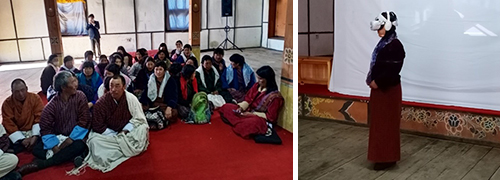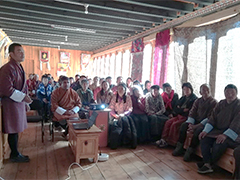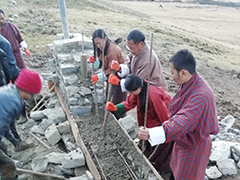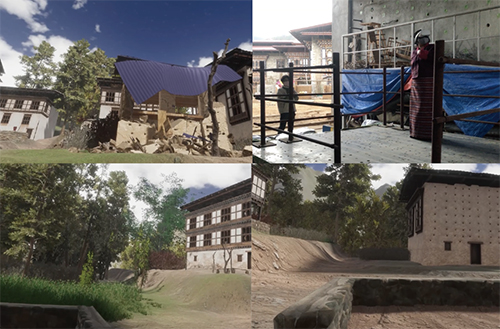Project News
2022-11-30
Monthly Report for November 2022
Conducted Public Awareness program in Pilot site, Ura, Bumthang Dzongkhag
On November 9, the Department of Culture (DOC), Ministry of Home and Cultural Affairs (MoHCA), Department of Disaster Management (DDM), MoHCA and Department of Engineering Services (DES), Ministry of Works and Human Settlements, conducted a disaster preparedness awareness program for residents at the pilot site Ulla. The Bumthang Dzongkhag Office and Ura Gewog office were called to support the event, and residents from each household in the Gewog participated in the event with the cooperation of the Gap of Ura Gewog.
First, DDM introduced the types of disasters that can occur in Bhutan, the damage caused by disasters, and measures to prevent damage from falling furniture and falling objects in preparation for earthquake damage. DOC and DES then explained construction methods for improving the seismic resistance of masonry buildings, which are common in this area. They also used 3D animations and videos created in the project to clearly show each process of building a house with a traditional design using the earthquake-resistant construction method.
In this awareness activity, we used VR (Virtual Reality) headsets and made residents experience a simulated earthquake. They can have an audio-visual experience of things falling and dropping, also getting cracking on the wall due to shaking when an earthquake occurs in a traditional house in Bhutan. They also had a simulated experience of preventing falls and drops by installing devices. The video that the participants were watching was projected on the screen and other residents could see it, so they all enjoyed learning. It was an activity that made me realize that enlightenment activities using VR are effective.
 Awareness Program (left), VR simulated earthquake experience (right)
Awareness Program (left), VR simulated earthquake experience (right)
Photo courtesy of DES
Conduct hands-on taraining (earthquake-resistant Stone masonry construction) by Department of Engineering Services and Department of Culture
From November 29th to December 2nd (4 days), the Department of Engineering Services (DES), Ministry of Works and Human Settlements and the Department of Culture (DOC), Ministry of Home and Cultural Affairs held hands-on training for Dzongkhag engineers and site builders (masonry foreman class) at the premises using of a Dzongkhag vocational training school. Trainees from two Dzongkhags (Bumthang and Mongar) where there are many masonry houses were invited, and 9 Mongar officials, 10 Bumthang officials, and 8 Bumthang masons participated. First of all, they will learn the methods and procedures with teaching materials that contain video examples of the construction of earthquake-resistant buildings. After that, using teaching materials for simulated masonry walls, practical instruction was given on the key points of seismic reinforcement work for foundations, walls, supports, and girders. It is important to understand construction methods and procedures and manage construction quality. For many of the participants, the process of building reinforced concrete pillars inside the wall was the first time they had seen it, but I explained that it was an important process for earthquake resistance. Using the stone wall constructed by the participants, they also learnt the retrofitting measures for existing houses. Participants commented that they were given a good opportunity to learn that even a building with traditional design and materials can be made earthquake-resistant by adopting a minimum amount of reinforced concrete reinforcement. Prefectural officials are asked to return to their workplaces and tell their colleagues about the content of the training.
 Explanation of the construction procedure by video
Explanation of the construction procedure by video
Photo courtesy of Nagoya City University (NCU)
 Earthquake resistance construction using a simulated wall
Earthquake resistance construction using a simulated wall
Photo courtesy of Nagoya City University (NCU)
Awareness activities linked with VR teaching materials and shaking table
On November 25th, the Department of Disaster Management (DDM) and the Department of Culture (DOC) conducted awareness activities using teaching materials that linked shaking tables and virtual reality (VR). Through our research and development so far, it is now possible to have a virtual experience (audio-visual experience) of an earthquake with a VR device (headset). Researchers on the Japanese side further linked this VR device with a shaking table, adding an element of experiencing shaking in addition to audio-visual, and developed a situation that is closer to an actual earthquake experience. We had an experience VR on the shaking table of the DOC. The VR equipment is linked to a sensor attached to the shaking table, and when the floor (shaking table) shakes, an earthquake occurs in the VR space in sync with the shaking, and the building in front of him/her collapses.
Participants commented that they felt as if they were experiencing an earthquake. In addition, there were comments that the synchronization of images (visual) and shaking (physical) is still insufficient, so we plan to improve it and complete it in March and use it for awareness activities.
 VR experience (Up Right), Virtual space on VR (Other three)
VR experience (Up Right), Virtual space on VR (Other three)
Photo courtesy of NCU
- About JICA
- News & Features
- Countries & Regions
- Our Work
- Thematic Issues
- Types of Assistance
- Partnerships with Other Development Partners
- Climate Change / Environmental and Social Considerations
- Evaluations
- Compliance and Anti-corruption
- Science and Technology Cooperation on Global Issues
- Research
- JICA Development Studies Program / JICA Chair
- Support for the Acceptance of Foreign HRs / Multicultural and Inclusive Community
- Publications
- Investor Relations
